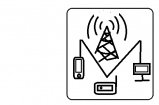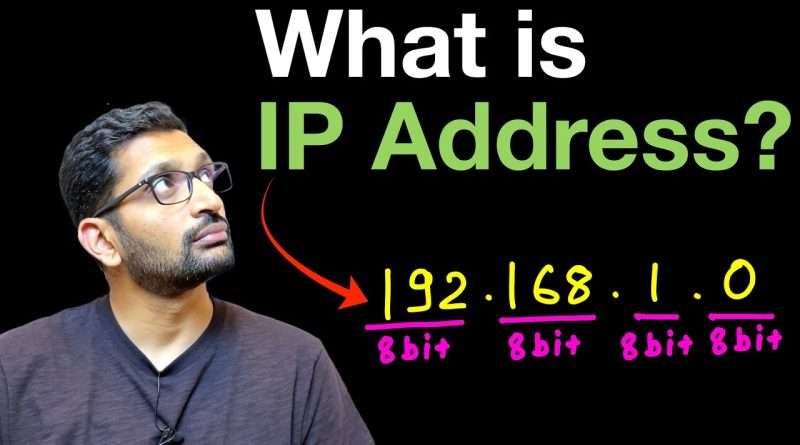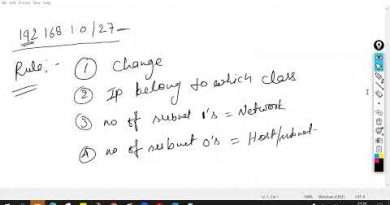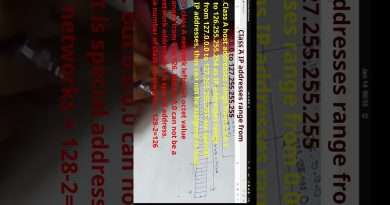What is IP Address?
▬▬▬▬▬▬ 🚀 Book Me for Consultation ▬▬▬▬▬▬
Calender – https://topmate.io/rahul_wagh17
▬▬▬▬▬▬ 🚀 Membership ▬▬▬▬▬▬
Join this channel to get access to perks:
https://www.youtube.com/channel/UC7p4oXcPbgk_yTSHK7QlkSg/join
▬▬▬▬▬▬ 📖 Time Stamps: ▬▬▬▬▬▬
00:00 – Introduction to IP (Internet Protocol)
00:35 – What is Packet Switching?
01:10 – Addressing and Routing Challenges to deliver packets correctly
01:24 – TCP/IP: The Backbone of the Internet
01:53 – Why IPv4 and the Structure of IP Addresses
03:47 – Public vs. Private IP Addresses Explained
05:17 – Understanding the Loopback Address
06:00 – What is a Broadcast Address?
06:26 – What is a Link-Local Address?
07:19 – Conclusion and Next Topics: CIDR, NAT, and IPv6
What is an IP (Internet Protocol)?
In the early days of computing, computers operated in isolation. However, as the need for communication between machines grew, the concept of networking was born. One of the first major steps in networking was the development of ARPANET (Advanced Research Projects Agency Network), which introduced the revolutionary concept of packet switching—the foundation of modern-day communication.
What is Packet Switching?
Traditional circuit switching required an operator to manually connect different lines to establish communication. In contrast, packet switching breaks data into small chunks (packets) and transmits them across a network, where they are reassembled at their destination.
Addressing and Routing Challenges
How can we ensure that data packets reach the correct destination, error-free?
Enter Vint Cerf and Bob Kahn, who designed TCP/IP, the Transmission Control Protocol/Internet Protocol. These protocols work together to guarantee that packets reach their destination reliably.
• TCP (Transmission Control Protocol): Ensures error-free delivery and reassembles packets at the receiving end.
• IP (Internet Protocol): Ensures that each packet is delivered to the correct destination.
Why IPv4? Understanding the Structure of IP Addresses
IPv4 is the fourth version of the Internet Protocol. Versions 1, 2, and 3 were experimental, but version 4 became the standard because of its use of four decimal numbers, separated by periods (e.g., 192.168.0.1). Each decimal represents 8 bits, for a total of 32 bits, allowing for 4.3 billion unique addresses.
However, we are running out of IPv4 addresses! To address this, IPv6 was developed, which will be covered in a future video.
Public vs. Private IP Addresses
Why should you care about public and private IP addresses?
Public IP addresses are visible to everyone on the internet, but for internal communications, we need private addresses that are hidden from the public. The IETF (Internet Engineering Task Force) established reserved ranges for private IP addresses:
• 10.0.0.0/8
• 172.16.0.0/12
• 192.168.0.0/16
These IP addresses are used internally and are not routable on the internet. I’ll also cover CIDR (Classless Inter-Domain Routing) and NAT (Network Address Translation), including an animated explanation.
What is a Loopback Address?
A loopback address (127.0.0.1) is used when a device wants to communicate with itself. For example, when you access 127.0.0.1 on your laptop, you’re staying within the machine and not traversing a network.
What is a Broadcast Address?
A broadcast address allows a message to be sent to all hosts within a specific network or subnet. For example, 192.168.1.255/24 can send a message to every host in the 192.168.1.0/24 subnet.
What is a Link-Local Address?
A link-local address is automatically assigned to a device when it can’t get an IP from a network, such as a router or DHCP server. These addresses (range: 169.254.0.0/16) allow devices on the same local network to communicate with each other, even without internet access.
IP Fragmentation and Maximum Transmission Unit (MTU)
Sometimes, IP packets are too large for certain network segments, which leads to fragmentation. The packet is divided into smaller fragments to fit within the network’s MTU (typically 1500 bytes for Ethernet). Setting the « Don’t Fragment » (DF) flag ensures the packet won’t be fragmented but may result in packet loss if the packet exceeds the MTU size.
Stay tuned for more in-depth discussions and tutorials on CIDR, NAT, IPv6, and other networking topics in future videos!
This refined version organizes the content logically and adds a polished, professional tone. You can adjust any sections as needed before uploading.
Views : 884
ipv4
Source by Rahul Wagh




